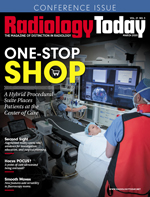 Imaging Informatics: Putting AI to Work in Radiology Screening
Imaging Informatics: Putting AI to Work in Radiology Screening
By Pooja Rao, MBBS
Radiology Today
Vol. 21 No. 3 P. 25
Radiology services in the United States and globally are being squeezed by increased demand for X-ray reads in emergency and preventive care, while the pool of available radiologists is dwindling at a rapid pace.
It is estimated that nearly one-half of radiologists in the United States are at or nearing retirement age. And a recent Wall Street Journal article highlighted widespread physician burnout. All of these factors will intensify the radiologist shortage by 2025. The landscape is equally dire globally as countries are experiencing similar shortages, along with an inability to provide reads in a timeframe that can positively impact care.
The continuing radiologist shortage is driving the adoption of emerging technology that employs AI and deep learning to help streamline triage and reduce the length of time from imaging to diagnosis and eventual treatment. Automated, AI-driven reading can integrate with existing radiology workflow solutions at the hospital level and via teleradiology. Particularly for countries with dispersed rural populations and lack of means to travel to on-premises screening locations, teleradiology is the only answer for effective diagnostic care.
For example, in Manila, Philippines, it was commonly taking up to 14 days for results on tuberculosis (TB) screenings. Using AI algorithms, the average time to diagnosis was reduced to four hours, and the AI-driven screening also identified 25% more TB cases. This time savings can benefit the United States as well. Interestingly, while TB does not receive as much attention domestically, data show that TB in the United States will not be eliminated in this century. According to the Centers for Disease Control and Prevention, as many as 13 million people in the United States may have latent TB infection; many of these people were born outside the United States, in areas of the world where TB is common, and therefore infected many years earlier. AI screening can detect these latent cases, particularly in high-risk populations. This can help prevent the spread of the disease.
Another AI use case is for detecting traumatic brain injury; such patients are often unconscious, making it difficult for emergency care physicians to ascertain their condition. AI-enabled CT scans that detect the nature and extent of injuries, in seconds, can help provide immediate treatment and improve patient outcomes.
Integrating AI
Given the fact that AI is an emerging technology, questions remain regarding how to integrate AI screening into existing health care systems and where to start. Five key areas of consideration in offering automated AI screening are as follows:
• Set rules for AI-enabled triage. Even with the efficiencies afforded by using AI as a diagnostic tool, protocol priorities must be set. Apart from trauma victims who must be seen first, health care staff, conferring with radiologists, need to determine the order of screening. In a busy emergency department, agreed-upon and well-defined protocols will help patient screenings go more smoothly.
• Determine the level of overall deployment for the use of deep learning in screening. Deep learning, the collection of knowledge and patterns gleaned by AI, is valuable for identifying disease patterns in a population and understanding the propensity for occurrence. Similar to setting AI triage guidelines, staff and radiologists should determine where deep learning protocols can provide the most value. These areas could include targeting chronic diseases such as TB, accelerating diagnostics for pediatric or high-risk patients, or using AI-powered information to mitigate a lack of available radiology staff.
• Plan for an effective ramp-up of technology through training. While AI may be highly valuable, personnel must also have a comfort level with the “machine” for it to succeed. AI screening technology should be user friendly and avoid a “black box” type of environment. Ideally, AI algorithms will enable true interpretability—by letting the user see where and why the AI algorithm has detected an abnormality.
• Ease integration of AI–deep learning solutions. Providers need to look for cloud-based solutions. Given that AI screening is helping patients in underserved regions, as well as high-population urban areas, a cloud-based platform will make it possible to access AI screening data from any location, in the United States or globally. This will also be of significant value in quickly communicating critical data results. Algorithms equipped to run on cloud hardware will limit on-site hardware requirements—in terms of both costs and logistics.
• Get ready to scale deployment. The challenges of deploying deep learning models are different from training them. During training, the focus is mainly on the accuracy of predictions, while deployment focuses on the speed and reliability of those predictions. Models can be trained on local servers but, in deployment, they need to be capable of scaling up or down, depending on the volume of application programming interface requests. Several companies are working to solve this problem by providing a layer over AI to serve end users.
As the radiologist shortage worsens, automated AI screening can help triage critical situations, detect previously undetected cases, and act as a second level of quality control for auditing and flagging discordant cases. Deep learning—collecting data to further identify patterns and improve screening accuracy—enhances the value of AI algorithms. By thinking through integration issues such as training, screening priorities, and cloud-based solutions, providers will be able to deploy AI screening in a timely fashion and begin achieving better patient outcomes.
While AI in general is a popular topic across industry sectors, AI in radiology is going beyond the hype and proving its value in care and cost efficiencies.
— Pooja Rao, MBBS, is the cofounder and head of research and development for Qure.ai.

